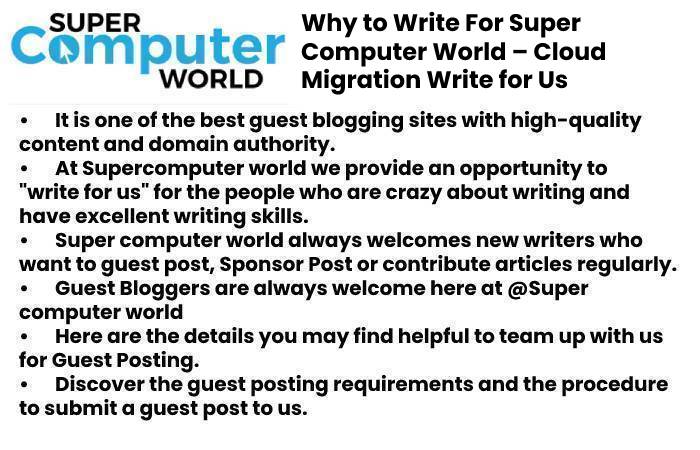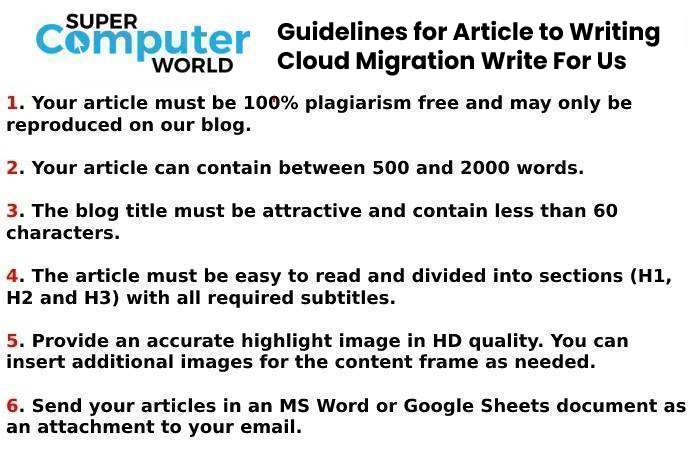Cloud Migration Write For Us

Cloud migration moves data, applications, or added business items to a cloud computing environment.
There are different types of cloud migrations a business can undertake. A common model is to move data and applications from an on-premises data center to the public cloud. However, a cloud migration can also involve moving data and applications from one platform or cloud provider to another; This pattern is known as cloud-to-cloud migration. The third type of migration is reverse cloud migration, cloud repatriation, or cloud egress. Data or applications are moved from the cloud and returned to an on-premises data center. For Submitting Your Articles, you can email us at contact@ SuperComputerWorld.com
What are the main benefits of migrating to the cloud?
The general goals or benefits of migrating to the cloud are essentially the same as the reasons for using the cloud: to host applications and data in the most efficient computing environment possible based on cost, performance and availability.
Many organizations are migrating on-premises applications and data from their on-premises data centre to public cloud infrastructure for benefits such as greater elasticity, self-service provisioning, redundancy, and a flexible payment model. to use.
Types of Cloud Migration Strategies
Moving workloads to the cloud need a well-thought-out strategy that includes a complex mix of management and technology challenges and a realignment of people and resources. There are options for the type of migration to perform and the type of data to move. It is important to consider the following cloud migration checklist before taking action.
What are the key benefits of touching the cloud?
Scalability – Cloud computing can scale to support larger workloads and more users than on-premises infrastructure, which requires organizations to purchase and configure physical servers, network hardware, or license additional software.
Expenses. Companies moving to the cloud often significantly reduce their IT operating costs as cloud service providers maintain maintenance and upgrades. Instead of staying in the know, companies can focus more resources on their core needs: developing new products or improving existing ones.
How it works: For some companies, moving to the cloud enables them to increase their customers’ productivity and improve the overall quality of service. Suppose your application or website is hosted in cloud data centres rather than multiple on-premises servers. Data does not have to travel far enough to reach users, and latency is reduced.
What are the biggest challenges moving to the cloud?
Transfer of large databases. Completely migrating databases to another platform are often necessary to work in the cloud. Moving a database is difficult, especially if you have large amounts of data. Some cloud providers offer physical methods of transferring data, such as downloading the data to a hardware device and then sending the device to the cloud provider for large databases that take too long to move over the Internet. Data can also be transmitted over the Internet. And also, Data transfer usually takes a very long time, regardless of the method used.
Data integrity. The next step after data transfer is to check their integrity, security, and the absence of data leaks.
Business Continuity – Organizations must ensure that their current systems remain operational and accessible during migration. Therefore, must be some overlap between on-premises and cloud to provide continuous service; For example, before shutting down an existing database, make a copy of all data in the cloud. In general, companies should change gradually, not all at once.
How does on-premises to cloud migration work?
Since every company has different needs, moving to the cloud will be slightly different. Therefore, Cloud providers can help companies adopt the migration process. Most migrations to the cloud involve the following basic steps:
Set goals: What operational improvements does the company expect? And also, On what day the existing infrastructure will become obsolete? Setting measurable goals will help the company determine if the migration was successful.
Create a security strategy – cybersecurity in the cloud requires a different approach to on-premises security. A firewall no longer protects corporate resources in the cloud, and the network perimeter is virtually non-existent. You may need to implement a cloud firewall or web application firewall.
Continuous data protection – choose a cloud provider and replicate existing databases. Therefore, It must be done continuously throughout the migration process to keep the cloud database up to date.
Moving Business Intelligence: This can include refactoring or rewriting code (see below). It can be completed slowly or all at once.
How to Submit Your Articles
For Submitting Your Articles, you can email us at contact@ SuperComputerWorld.com
Why to Write For Super Computer World – Cloud Migration Write for Us
Guidelines for Article to Writing Cloud Migration Write For Us
Search Related Terms to Cloud Migration Write For Us
Programs
programmable logic controller
Software migration
platform
reengineering
Cloud Computing
Micro Focus
Oracle Tuxedo Application Rehosting Workbench
LINC 4GL.
Data conversion
JOVIAL
Data migration
Data transformation
Software modernization
List of Linux adopters
Search Terms for Cloud Migration Write For Us Write For Us
Cloud Migration Write For Us
looking for guest posts
guest posting guidelines
become a guest blogger
guest post
becomes an author
suggest a post
contributor guidelines
guest posts wanted
submit an article
writers wanted
guest posts wanted
submit the post
contributing writer
Related Pages
Endpoint Security Write For Us
programming language write for us



